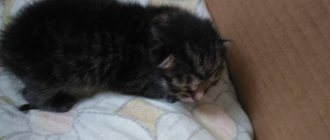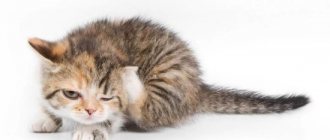Giving birth to a cat is an exciting process for the pet and its owners. The birth of one baby, contrary to the expected brood, raises concerns. Perhaps the cat did not give birth to all the kittens and surgery is necessary to remove the remaining cubs in the womb. But you should not panic if there is only one kitten in the mother's litter. In this case, all that is required from the owners is knowledge of the physiology of the pet and the ability to distinguish normality from pathology in time.
Features of feline birth
Any cat owner should be aware of the nuances of their pet's reproduction and the stages of pregnancy. It is recommended to perform an ultrasound on the animal in time to ensure normal gestation and determine the number of kittens in the womb. You can find out about an approaching birth by the characteristic behavior of a cat: the expectant mother rushes around the apartment in search of a secluded place, licks her belly, and loses interest in food. Contractions begin after the mucous plug and amniotic fluid have drained. As a rule, kittens are not born immediately, but at intervals of 15-120 minutes. In some cases, the entire labor period lasts up to one and a half days. On average, a litter of a healthy and mature pet contains from 4 to 6 babies.
Yard cats, unlike their purebred counterparts, tend to be more fertile, and their births are easier. In addition, first-born cats are characterized by a small litter: no more than one or two kittens per litter.
It is advisable that a doctor be present at the first lambing of your pet.
It should be understood that during childbirth the animal is especially vulnerable, so it is necessary to notice the signs of an imminent birth in time and be close to the animal at the crucial moment. Usually a woman in labor copes with her task without any problems, but in some cases she cannot do without human help. It is recommended to take the first birth under the supervision of a veterinarian.
"Sex machines" and pregnancy
Our favorite cat = Nut. Editorial cat.
If you have a British child, then know that he is at risk.
Siamese cat
And, of course, it’s worth mentioning the unique sex machines in cat form. British and Siamese cats tend to yell (beg for a cat) during almost the entire pregnancy . And the most temperamental cats, fortunately, are very rare; some kittens are fed, others are carried, and others have already been identified and require a cat.
Reasons: why is only one kitten born?
There is no need to worry, as the likelihood of having an only baby, especially in a young cat, is more common than it might seem. The physiological reasons why one kitten may be born are not related to health anomalies, and are most often associated with age or the course of pregnancy in the early stages. However, among the factors associated with singleton pregnancy, shortcomings in animal care often appear.
The main reasons for the birth of one kitten:
This phenomenon can be observed in older females.
- Heredity. Some breeds, for example, Persian cats, are characterized by a minimum number of kittens in the litter. Genetic predisposition also influences the offspring. This happens if several generations in a pet’s family produced only one cub.
- Age. A cat that is too young or old is more likely to give birth to one kitten. The first pregnancy in an animal, as a rule, often ends in the appearance of a single calf.
- Physical state. The formation of kittens largely depends on the resources of the mother’s body. With a lack of vitamins and poor nutrition, a cat may produce a litter only once, and an exhausted animal may not reproduce at all.
- The only egg fertilized during mating.
- Reproductive function of a cat. The health, age and fertility of the partner affect the quality and quantity of semen, and therefore the success of fertilization.
- Intrauterine processes. Not all fertilized eggs attach to the wall of the uterus, and at a later date, resorption of the fetus may occur in the cat.
Animal behavior
Pregnant cats also change their behavior. From the first weeks, you can notice that expectant mothers become inactive: they will not play with you, jump, jump with the same desire, they prefer to spend more time lying down, sleeping longer.
Sometimes a cat can show anxiety: look under furniture, sniff things, meow. Try to calm her down, and the worries will pass.
Also, pets become more affectionate and sociable. They will follow the person and look for support, laying down next to you.
Photo: pregnant cats are inactive
The cat can climb onto your bed, snuggle and fall asleep, so she will feel calmer. Don't send her away. Spend time with your mother cat more often, this will help calm her down.
Pregnant pets sometimes surprise their owners with sudden changes in mood and behavior. She may be sleepy in the morning, but start running in the evening. A usually sociable cat may become quiet for a while and try not to be seen.
Don't be offended by her if she hisses at you for no apparent reason - pregnant cats are prone to mood swings. After a while, she will definitely come up with a purring apology.
In the last weeks of pregnancy, cats become heavy and can no longer jump onto their favorite chair with the same ease. Try to help them. It will be better if by this time you have already made a “nest” that will stand on the floor.
When should you contact a veterinarian?
An alarming factor is the pet staying in one position for a long time and its restless behavior.
As a rule, a healthy female gives birth to kittens without complications. You can guess that the birth has been successfully completed by the behavior of the mother cat: she is calm, purrs, licks her offspring, and has an appetite. After 40 minutes, the cat’s belly becomes soft, the uterus loses its tone, and no lumps can be felt. However, even a healthy cat who has given birth before can experience complications, particularly if the fetus is too large or incorrectly presented. A number of symptoms may indicate that the kitten is stuck in the birth canal and is unable to give birth on its own:
- Long (more than 40 minutes) unsuccessful attempts.
- The animal does not change its position for a long time and meows restlessly.
- Bloody discharge does not stop from the birth canal.
- Lack of interest in newborn kittens.
- Fever, increased temperature in the next day.
- Maintaining abdominal tone for more than 40 minutes, detecting other babies upon palpation.
The process of producing offspring that takes too long can be accelerated with Oxytocin.
Prolonged labor increases the risk of a dead kitten. To stimulate the process, it is recommended to inject 0.3 ml of oxytocin intramuscularly or into the withers. The use of the drug is permissible after the first baby is born. In more difficult cases, it is impossible to help the mother in labor on her own, and surgical intervention is required for resolution. It is important to notice dangerous signals in the animal’s behavior in time: untimely contacting a veterinarian is fraught with injury to the cat and offspring, and rotting of a dead fetus in the birth canal leads to intoxication and death of the mother.
Is there a chance to save a kitten during a caesarean section?
The doctor cannot guarantee that unborn kittens can be saved by caesarean section. Since it is possible that the fetuses died due to hypoxia due to their prolonged stay in the uterus. The operation is more necessary for the cat itself to save its life.
Sometimes surgical intervention cannot be performed urgently due to contraindications. This is due to the fact that the operation requires stable operation of all body systems, but if the animal has a violation of cardiac and respiratory functions, it may not withstand the load and die.
If the kittens suffocated in the womb, and the decomposition process has already begun, performing a cesarean section is pointless, since necrotic changes spread to the uterine cavity.
This requires surgery to remove the organ and ovaries, since there is a high risk of developing septic complications and death.
What to do if a pregnant cat has fleas?
Removing fleas is usually not a problem - there are a lot of remedies for this problem on sale. But what to do if the cat is pregnant, because chemistry can have a negative impact on future offspring?
In this case, you can treat the animal’s fur with Frontline spray; it has no contraindications such as pregnancy. The main thing is to follow the instructions and not let the cat lick itself until it dries out. However, to be on the safe side, it is best to consult a veterinarian before using any antiparasitic drug.
Calendar in a matter of days
First week
The first week after mating of a female with a male passes without a trace. The fertilized egg does not reveal itself in any way, so the owners will not immediately be able to understand whether the cat got pregnant or not. But it is during this first week that if the sperm reaches the egg, it fertilizes it. Next, the fertilized egg begins to move; it will move to its home for the near future - the uterus.
Surprisingly, if a cat is mated with different cats at the same period of conception, then she can bear children from different cats.
Second week
In the second week (from the eighth to the fourteenth day), moving eggs reach the uterus. After which they plunge into it, and the process of forming kittens begins.
Third - fourth week
Over the next two weeks (from the fourteenth day to the twenty-seventh), the conceived embryos enter the process of organ development. For these reasons, the cat's hormonal levels change dramatically, which can affect its mood, appetite and sleep. Also, by its appearance it will already be possible to recognize that the cat is pregnant. Because her nipples drop lower (swell) and can be either dark or pink.
It is during this third and fourth week of pregnancy that the cat may feel gag reflexes, so it will refuse even its most favorite food. There may also be vomiting, so it is necessary to monitor the animal very carefully, because if it is very frequent and the cat feels very unwell, then it is necessary to show it to the veterinarian.
At about 4 months of pregnancy, an experienced doctor can already feel the babies in the belly of the pet, however, this is best done with the help of an ultrasound. It is during this period that the cat should be carefully protected and taken good care of. Do not lift the cat under any circumstances, as you may crush the kittens. It is especially important to consult your children on this issue.
Fifth week
In the fifth week, if you have not found out that your cat is pregnant, it is time to show her to the doctor. Using palpation or ultrasound, the doctor will tell you whether there is a pregnancy, how it is progressing and how many kittens the expectant mother is carrying.
Sixth - seventh week
Starting from the sixth week of pregnancy (from thirty-five to forty-two days), you can see the kittens moving in the womb, of course, if your female is not too fluffy. It is during this period that her health should improve, so a good appetite may awaken. Do not deny anything to a pregnant woman! Give as much as she wants to eat, remembering that she feeds not only herself, but also future offspring. At the same time, food must be of high quality and balanced.
Over the next week, even outsiders will be unable to help but notice that your lady is pregnant. Because you can hardly hide a round belly.
Eighth week
With the onset of the fiftieth day after conception (eighth week), the cat begins to carefully care for itself. Her nipples become even larger, more prominent and pinker. During this period, the cat may shed heavily; this is normal while bearing cubs. Thus, the cat seems to be preparing for childbirth. After the kittens are born, the fur will definitely grow back.
As this week progresses, the cat's appetite may decrease as the fast-growing kittens take over all the space in their mother's tummy (and do not overfeed the cat too much, as the kittens may outgrow and the cat will have a difficult time giving birth). The closer to childbirth, the more likely it is that the female begins to look for a place to give birth. If you notice something strange in her behavior, try placing a box or basket in which you place a sterile soft cloth.
During this period, you can very easily feel the presence of babies in the cat’s womb. And also the release of milk from the cat’s nipples indicates that the body is already preparing for the birth of new offspring. You can easily see this because very often it dries out at the ends of the nipples.
The ninth week is a harbinger of labor
The crucial moments begin! As you approach the ninth week (56 to 62 days), your cat may experience a reddish vaginal discharge. There's nothing wrong with that. As the kittens get bigger and bigger, labor can begin at any time. See also pregnancy and childbirth of a British cat.
In principle, by the behavior of the expectant mother, you can notice the onset of labor, because she:
- may feel restless;
- do not leave your owners;
- meow for no reason;
- hiding in your birthing nest.










